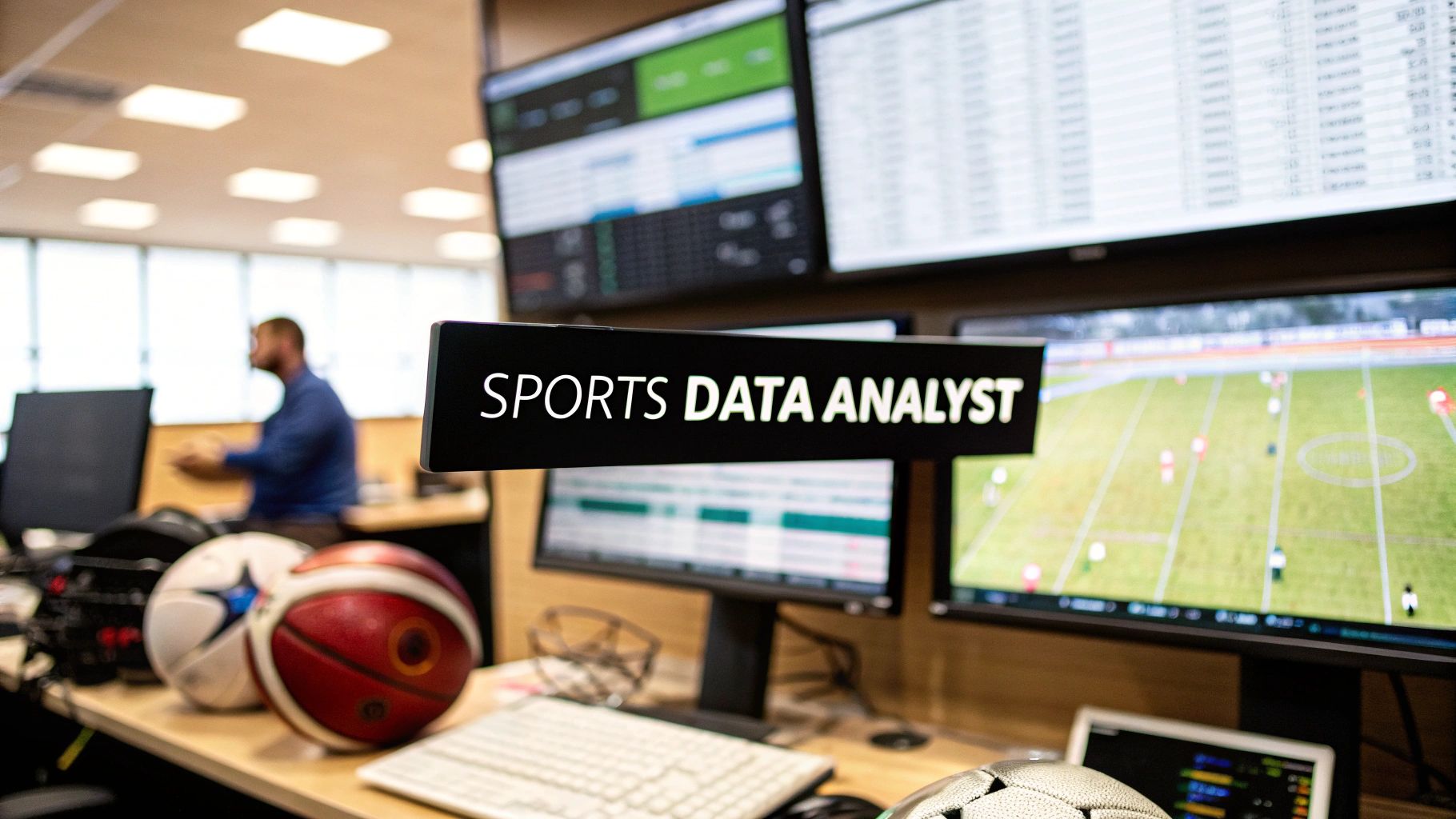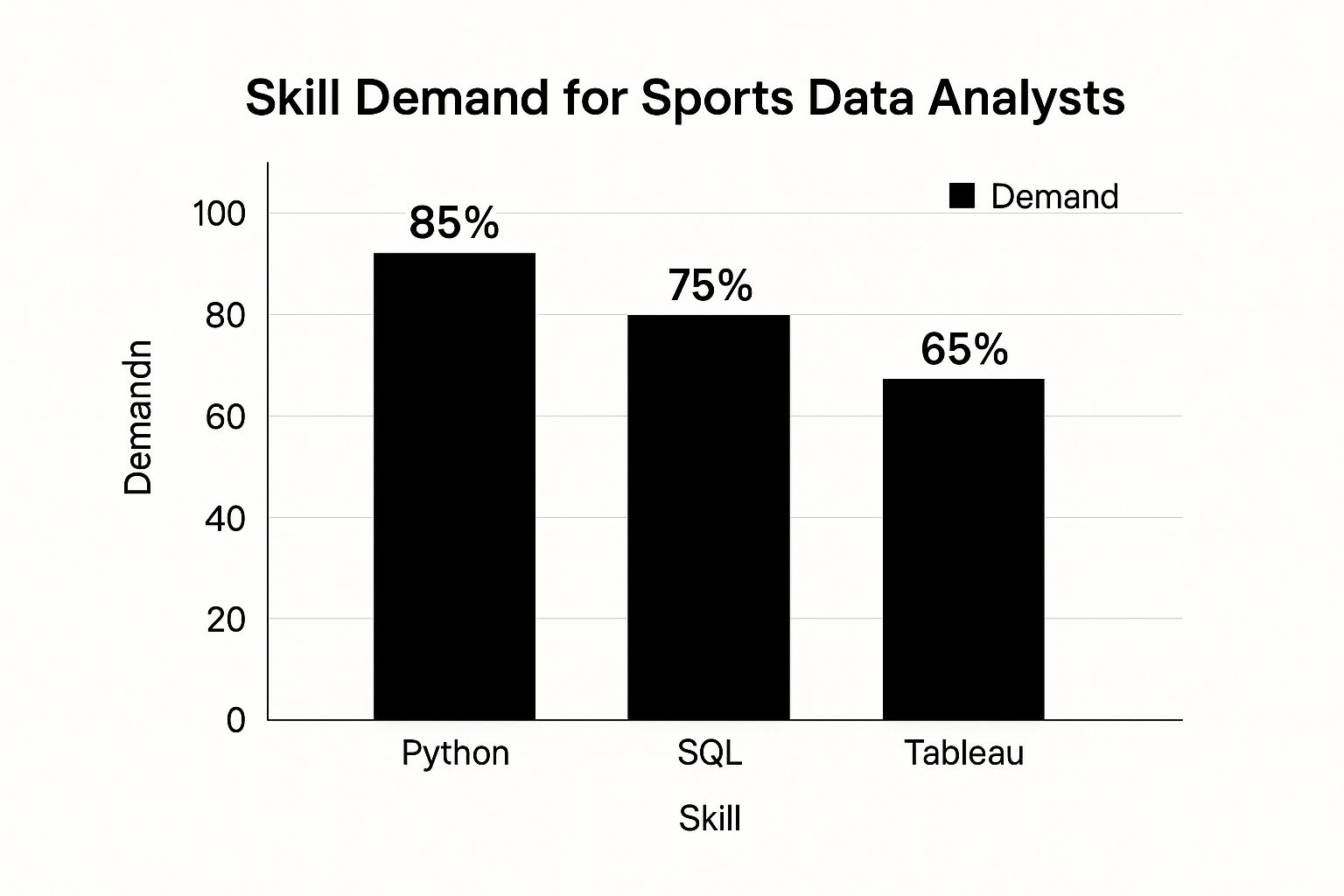
Sports Data Analyst Job Description Uncovered
A sports data analyst role is all about collecting, cleaning, and digging into sports-related data to pull out insights that actually mean something. These pros use statistical analysis and data modeling to guide team strategy, boost player performance, and even help with business decisions.
Basically, they turn a sea of raw numbers into a real competitive advantage.
What Does a Sports Data Analyst Really Do?

Think of a sports data analyst as a master strategist, but their primary weapon is data. Instead of just going with gut feelings, they use hard evidence to find hidden patterns and opportunities that can totally change the outcome of a game or even an entire season. Their work is a cool mix of deep sports knowledge and sharp technical skill.
At its core, the job is about turning raw information—stuff like player tracking data, scouting reports, and old game stats—into game-winning intelligence. This isn't just about crunching numbers; it's about telling a story with that data. An analyst might build a model to figure out which free agent offers the best bang for the buck or spot a tiny weakness in an opponent's defense that the coaches can exploit.
From On-Field Tactics to Business Strategy
The influence of a sports analyst goes way beyond the field or court. Their duties often connect team performance directly to the business side of the organization. This dual focus is a huge part of any modern sports data analyst job description.
You’ll see their work touch on everything from in-game tactics to long-term financial health. The role is becoming more and more professionalized as the industry explodes. In fact, the global sports analytics market is expected to hit a staggering $4.6 billion by 2025, a massive leap from its $880 million value in 2020. That kind of growth shows just how much teams and organizations are relying on analysts to find an edge.
To give you a clearer picture, here's a quick breakdown of what a sports data analyst typically handles.
Key Responsibilities of a Sports Data Analyst at a Glance
| Responsibility Area | Description | Example Application |
|---|---|---|
| Performance Analysis | Evaluating player efficiency, identifying strengths, and pinpointing areas for improvement. | Creating a report that shows a basketball player's shot efficiency from different spots on the court. |
| Tactical Support | Working directly with coaches to develop game plans and analyze opponents. | Identifying an opponent's go-to plays on third down in football based on historical data. |
| Talent Identification | Using statistical models to scout and recruit players who fit the team’s system. | Building a model to predict a college player's potential success in the professional league. |
| Business Insights | Analyzing ticket sales, fan engagement, and merchandise trends to grow revenue. | Using fan data to determine the best time to launch a new line of team apparel. |
As you can see, the job is about finding that competitive advantage, wherever it might be hiding.
The modern sports analyst is a hybrid professional—part statistician, part storyteller, and part strategist. Their value lies in their ability to translate complex data into clear, actionable insights that give their organization a measurable edge.
Ultimately, it’s about making smarter decisions, whether that's a small tactical tweak or a major player signing. Roles like an Analyst for Performance with Youth National Teams show how data is being used at every level of sports to develop talent and build winning programs from the ground up.
What Does a Sports Data Analyst Actually Do Day-to-Day?

While the job title sounds glamorous, a huge chunk of an analyst's day is spent on something crucial but not exactly thrilling: data wrangling.
Think of it like being a chef. Before you can cook a masterpiece, you have to prep your ingredients. Raw data from player-tracking systems, scouting reports, and historical archives is almost always messy. It's inconsistent, full of errors, and rarely ready to use straight out of the box.
So, a lot of time is spent cleaning and organizing this data. This means standardizing player names across different files, fixing typos, and merging separate datasets into one coherent whole. Without this grunt work, any analysis you build on top would be like a house built on sand—ready to collapse.
Once the data is clean, the real fun begins. The core of the job is performance analysis, which is all about using statistics to see players and teams in a new, objective light. We're talking way beyond simple box scores.
From Raw Numbers to Tactical Gold
An analyst might build a model to figure out which quarterback really performs best under pressure or which five-player lineup in basketball is the most dominant. The whole point is to find the hidden strengths and subtle weaknesses that you'd never spot just by watching the game. This is where you turn a spreadsheet of numbers into a powerful story about performance.
Those insights are useless if they stay on a computer screen. This leads to another key duty: tactical support. An analyst doesn't just find cool patterns; they have to translate them into advice a coach can actually use. This back-and-forth between the analytics department and the coaching staff is what defines a modern sports data analyst job description.
For instance, an analyst might show a coach a report proving an opponent is consistently vulnerable to counter-attacks down their left flank. That single, data-backed insight can shape the entire week's training and the game plan for Saturday.
"A sports data analyst acts as a translator. They must speak the language of both data and sport, converting complex statistical outputs into simple, powerful strategies that a coach can use on game day."
This isn't about emailing a spreadsheet and calling it a day. The best analysts create compelling data visualizations—like heatmaps and shot charts—that make their findings instantly obvious to someone who doesn't live in a world of stats. They tell a story with the data.
Impacting More Than Just the Game
The job doesn't always stop at the final whistle. A sports data analyst's responsibilities often bleed into the front office, helping drive the business side of the team, too.
On the business side, their duties might include:
- Fan Behavior Analysis: Digging into ticket sales, social media chatter, and merchandise trends to figure out what the fans truly want.
- Ticket Price Optimization: Using data to find that sweet spot for ticket prices that brings in the most revenue without pricing out loyal supporters.
- Sponsorship ROI: Actually measuring if a big-money sponsorship deal is working by analyzing brand exposure and fan sentiment.
This commercial side of the job ensures the organization isn't just winning on the field but is also a healthy, sustainable business. By blending on-field analytics with business intelligence, the analyst becomes a key player in the team's all-around success.
Building Your Essential Skill Set

To make it as a sports data analyst, you need a toolbox loaded with both hardcore technical skills and sharp communication. Just knowing the sport isn't enough, and being a coding wizard won't get you far on its own. The real magic happens when you combine the two.
Think of it like this: your technical skills are the engine of a race car, but your sports knowledge is the steering wheel. One without the other is useless. You need the engine to process data and build models, but you need the steering wheel to ask the right questions and drive your analysis toward a meaningful finish line.
This blend is exactly what hiring managers are hunting for. Let's break down what you need to master.
The Technical Toolkit
At the core of the job is your ability to wrangle data. This means getting fluent in the specific programming languages and tools that have become the industry standard for statistical work and data management.
Your essential technical skills have to include:
- Python or R: These are the big two for statistical modeling and machine learning. You’ll be using them to build predictive models, run complex simulations, and spot trends that are completely invisible to the naked eye.
- SQL (Structured Query Language): This is the key that unlocks the data vault. You need SQL to pull, filter, and organize information from the massive databases where teams store their mountains of historical data.
- Data Visualization Tools: Simply finding an insight isn't enough; you have to sell it. Tools like Tableau or Power BI are non-negotiable for creating interactive dashboards and clean charts that turn dense spreadsheets into stories a coach can understand in seconds.
The demand for these skills is exploding. The US Bureau of Labor Statistics projects a massive 23% increase in data analyst roles by 2032. That trend is hitting the sports world hard, with jobs requiring this exact toolkit popping up constantly.
Beyond the Code: Soft Skills
Technical ability gets you the interview, but soft skills get you the job and help you thrive. Your real value comes from connecting your findings to the actual game being played on the field or court.
A great analyst doesn't just hand over a spreadsheet of numbers. They tell a story. They explain why a certain player's performance drops in the fourth quarter, not just that it does.
This is where your domain knowledge becomes a superpower. Truly understanding the rules, the strategies, and even the culture of a sport is what builds trust with coaches and makes your analysis relevant. On top of that, you need killer communication skills to explain complex ideas to people who don't speak code.
A role like a Pipeline Programmer, for example, is a perfect illustration of where deep technical skill has to meet the practical, day-to-day needs of a sports organization.
Salary Insights and Career Growth
Let's get down to brass tacks: What can you actually earn, and where can this career take you? The good news is that the outlook for a sports data analyst is strong. More and more, the sports industry isn't just using data—it's relying on it for mission-critical decisions.
From multi-million dollar player acquisitions to fine-tuning fan experiences, data-driven insights are now a core part of the business. This has created a clear and rewarding career ladder for analysts who know their stuff.
Of course, your paycheck will vary. It depends on your experience, where you're located, and who you work for. An analyst for a major league team in a big city will naturally command a higher salary than someone at a smaller club or a sports media startup. Your specific expertise also moves the needle. Mastering the right skills directly boosts your earning potential.
This image breaks down the most sought-after technical skills you'll see in a typical sports analyst job description.

It’s crystal clear: a solid foundation in Python and SQL is non-negotiable. On top of that, you need to be able to tell the story behind the numbers, which is where visualization tools like Tableau come into play.
Breaking Down the Pay Scale
So, what do the numbers look like? Recent data shows that the average salary for a sports statistical analyst in the United States is around $70,450 per year. But think of that as a baseline, not a ceiling.
The salary landscape shows significant room for growth as you build experience and specialized skills. Let's look at how compensation tends to progress.
Sports Data Analyst Salary by Experience Level (US Average)
| Experience Level | Average Annual Salary Range | Key Differentiators |
|---|---|---|
| Entry-Level | $58,500 - $70,000 | Focuses on data cleaning, reporting, and assisting senior analysts. Strong foundational skills in SQL and a visualization tool are key. |
| Mid-Level | $70,000 - $90,000 | Manages independent projects, builds basic predictive models, and presents findings. Expertise in Python or R becomes more important. |
| Senior/Lead | $90,000 - $115,000+ | Leads complex analyses, mentors junior staff, and influences strategy. Deep expertise in machine learning and statistical modeling is required. |
As you can see, top earners—those in the 90th percentile—can command salaries well over $105,000 annually. The wide range proves that this isn't a dead-end job; it’s a field where your expertise is directly rewarded. You can dive deeper into these salary benchmarks and see how they vary by location on ZipRecruiter's salary data page.
A sports data analyst's career path is not a flat line. It’s a ladder. With each step, you take on more strategic responsibility, moving from executing analysis to shaping the entire analytical direction of the organization.
The Climb Up the Career Ladder
The journey doesn't stop at "analyst." For most, it's just the first rung. Ambitious analysts often grow into senior roles where they're not just running the numbers but overseeing entire departments and influencing major front-office decisions.
A typical career path might look something like this:
- Entry-Level Analyst: Your focus is on the fundamentals—cleaning data, running routine reports, and supporting the senior staff. You're learning the ropes.
- Senior Analyst: You're taking the lead now. You'll handle complex projects, build predictive models, and present your findings directly to coaches and executives.
- Director of Analytics: You've made it to the strategy table. You're managing the analytics team, setting the vision, and ensuring all data initiatives align with the organization's biggest goals.
This climb shows a clear evolution from a hands-on technical expert to a strategic leader. Roles like a Research & Development Analyst are great examples of these more advanced positions, where you're tasked with driving long-term innovation for the team.
Your Roadmap to Becoming a Sports Analyst
So, you want to break into sports analytics? It might look like a tough world to crack from the outside, but it's a path you can absolutely navigate with the right moves. It's not about finding one secret trick; it's about methodically building your skills and experience until teams can't afford to overlook you.
Think of this as your game plan.
A look at any sports data analyst job description will show you that the starting point is usually a degree. Getting a bachelor's in a field like statistics, math, computer science, or even economics is the standard ticket to the game. This is where you learn the theory—the why behind the numbers and models you'll be building.
But let's be real, a degree by itself isn't what gets you hired. Where you really start to stand out is by proving you can apply that knowledge.
Master the Technical Tools of the Trade
You can't be an analyst without your tools, just like a mechanic can't fix a car without a wrench. Getting your hands dirty with the industry-standard software isn't just a good idea; it's essential.
You'll want to get comfortable in a few key areas:
- SQL: This is your key to the data vault. You have to be able to write queries to pull, slice, and combine data from massive databases.
- Python or R: Pick one and dive deep. These are the languages where the real magic happens—running statistical analyses, building predictive models, and simulating game scenarios.
- Tableau or Power BI: Data means nothing if you can't explain it. These tools are how you turn spreadsheets into powerful stories that a coach or a GM can grasp in seconds.
This is your core toolkit. Every project you tackle adds another layer of skill and gets you one step closer.
Gain Hands-On Experience and Build Your Portfolio
This is the part that separates the dreamers from the doers. Real-world experience is what gets you noticed, and the good news is you don't need a job to get it. You just need to start building.
Dive into personal projects. Grab some public data from sites like Kaggle, StatsBomb, or Understat. Break down a recent game, build a simple model to predict a player's next-season performance, or create a cool visualization that shows a trend nobody is talking about.
A portfolio is your professional highlight reel. It’s tangible proof of your skills and, more importantly, your passion. It shows you’re not just looking for a job—you’re obsessed with solving the puzzles of the game.
For every project you finish, document it. Put your code on GitHub and write up your findings on a personal blog or online portfolio. This becomes the evidence you present to a hiring manager, proving what you can bring to their team.
Network and Connect with the Industry
Finally, you need to get seen. The sports analytics world is smaller than you think, and making connections is huge. Start by following and engaging with analysts and other sports tech folks on LinkedIn and X (formerly Twitter).
Attending conferences, even virtual ones, can be a massive boost. Events like the MIT Sloan Sports Analytics Conference put you in the same room (or chat) as the best in the business. Just by listening and participating, you show you're serious.
It’s this mix—education, tech skills, a solid portfolio, and a growing network—that makes up your roadmap. Follow it step by step, and you'll build the kind of profile that makes hiring managers sit up and take notice.
Common Questions About the Sports Analyst Role
As you start digging into any sports data analyst job description, the practical questions start piling up. It's one thing to learn the theory, but it's another thing entirely to navigate the real-world hiring process, understand the day-to-day grind, and figure out where the best jobs are hiding.
Let's cut through the noise. This section tackles the most common questions I hear from aspiring analysts, giving you the straight answers you need to map out your own journey into this incredible field.
Do I Need to Be a Former Athlete to Get Hired?
This is probably the biggest myth out there. The short answer? No. You absolutely do not need to have played professionally, or even in college, to get hired as an analyst.
Sure, firsthand playing experience can give you a unique feel for the game, but it's not what teams are actually hiring for. They're looking for analytical horsepower—your ability to dive into data, uncover meaningful patterns, and translate those insights into a real strategic edge.
Think of it this way: a team needs someone who can build a model to flag undervalued players in the draft, not someone who can demonstrate a perfect jump shot. Your deep understanding of the sport's numbers, strategies, and statistical nuances is what truly matters.
What Does a Typical Interview Process Look Like?
Getting a job as a sports data analyst isn't just about what's on your resume. It's a multi-stage gauntlet designed to see if you can actually do the work.
The journey usually looks something like this:
- Initial Screening: This is a basic gut-check call with a recruiter or hiring manager. They want to hear about your background, confirm your passion for the sport, and see if you have the core qualifications.
- Technical Assessment: Here's where you prove your skills. Expect a take-home project or a live coding test. You'll be given a real-world problem and asked to solve it using tools like SQL, Python, or R.
- Final Interviews: If you nail the technical round, you'll meet the key people. This could be the Director of Analytics, coaches, or even front-office execs. They're looking at your communication skills and whether you'll be a good fit for the team's culture.
The technical interview is everything. It’s where you show you can go beyond just talking about analytics and actually deliver the kind of insights that a modern sports data analyst job description is built around.
Which Sports Have the Highest Demand for Analysts?
While just about every sport is getting on the analytics train, the opportunities aren't spread evenly. The biggest demand comes from sports that produce a firehose of data and have clear, countable events.
Baseball, with its deep roots in sabermetrics, is still a huge employer of analysts. Basketball and soccer are right there with it, using sophisticated player-tracking data to break down everything from shot selection to defensive formations.
But don't sleep on the emerging frontiers. Sports like Formula 1, golf, and the exploding world of esports are building out their data teams like crazy. These fields are hungry for talent and represent a massive opportunity to get in on the ground floor.
How Can I Get Experience While Still in College?
Don't wait until graduation to start building your resume. Getting hands-on experience while you're still in school is one of the single best things you can do to get ahead of the pack.
Start with personal projects. Grab some free, public datasets from sites like Kaggle or StatsBomb and start analyzing. Find a trend, evaluate a player, and turn your work into a blog post or a cool data visualization.
Next, get your work out there. Build a portfolio on a platform like GitHub to show off your code and projects. Finally, talk to your university's athletic department—you'd be surprised how many are open to volunteers who can help them make sense of their data.
Ready to turn your passion for sports and data into a career? Sportsjobs Online is the premier job board for sports analytics roles, connecting talented analysts with top teams and companies. Find your next opportunity and start your journey today.
Hundreds of jobs are waiting for you!
Subscribe to membership and unlock all jobs
Sports Analytics
We scan all major sports and leagues
Updated Daily
New jobs are added every day as companies post them
Refined Search
Use filters like skill, location, etc to narrow results
Alerts
You can get daily alerts in your email for a specific search
Access to job postings from top teams and companies
Daily updates and notifications based on your preferences
🎯 Over 90% of customers chose to renew their subscriptions after the initial sign-up
Monthly
$6.99
per month
✓ Flexible monthly billing
✓ Unlimited access to all jobs
✓ Advanced filtering tools
✓ Daily job alerts
✓ Exclusive discount codes
✓ Cancel anytime
BEST VALUE
Yearly
$39
per year • Only $3.25/mo
✓ Save 50% vs monthly
✓ Unlimited access to all jobs
✓ Advanced filtering tools
✓ Daily job alerts
✓ Exclusive discount codes
✓ Cancel anytime
Lifetime
$59
one-time • forever
✓ Pay once, access forever
✓ Unlimited access to all jobs
✓ Advanced filtering tools
✓ Daily job alerts
✓ Exclusive discount codes
✓ Best long-term value